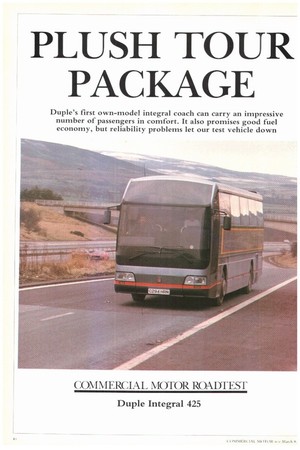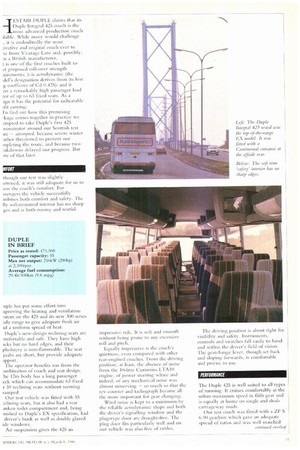PLUSH TOUR PACKAGE
Page 40

Page 41

Page 42

If you've noticed an error in this article please click here to report it so we can fix it.
Duple's first own-model integral coach can carry an impressive number of passengers in comfort. It also promises good fuel economy, but reliability problems let our test vehicle down
4 DUPLE UPLE claims that its
Duple Integral 425 coach is the most advanced production coach ilablc. While many would challenge , it is undoubtedly the most ovativc and original coach ever to IC from Vicarage Lane and, possibly, al a British inanuthcturer.
t is one of the first coaches built to et proposed roll-over strength uirements; it is aerodynamic (the ,ders designation derives from its loW g coefficent of Cd 0,425); and it ers a remarkably high passenger load tor of up to 63 fixed seats. As a ign it has the potential for unbeatable & it earning.
fo find out how this promising :kagc conies together in practice we tinpted to take Duple's first 425 :nonstrator tround our Scottish test in: — attempted, because severe winter ',idler threatened to prevent our rnpleting the route, and because two fakdowns delayed our progress. But are of that later.
FORT though our test was slightly
ortened, it was still adequate for us to ;ess the coach's comfort. For
ssem,rers the vehicle successfully mbines both comfort and safety. The lly soft-trimmed interior has no sharp ges and is both roomy and restful.
uple has put sonic effort into nproving the heating and ventilation 'stem on the 425 and its new 300 series ady range to give 'adequate fresh air ad a uniform spread of heat.
Duplc's new-design reclining seats are mnfortable and safe. They have high acks but no hard edges, and their phoistery is non-flammable. The seat luabs are short, but provide adequate ipport.
The operator benefits too from the ambination of coach and seat design. 'he 12m body has a long passenger eck which can accommodate 63 fixed r 59 reclining seats without seeming ramped.
Our test vehicle was fitted with 55 :dining seats, but it also had a rear anken toilet compartment and, being nished to Duple's EX specification, had driver's bunk as well as double glazed ide windows.
Air suspension gives the 425 an impressive ride. It is soft and smooth without being prone to any excessive roll and pitch.
Equally impressive is the coach's quietness, even compared with other rear-cu gin coaches. From the driving position, at least, the absence of noise from the 10-litre Cummins LTA 10 engine, or power steering whine and indeed, of any mechanical noise was almost unnerving, — so much so that the rev counter and tachograph became all the more important for gear changing.
Wind noise is kept to a minimum by the reliable aerodynaniic shape and both the driver's signalling window and the plug-type door are draught-free. 'fbe plug door fits particularly well nud on our vehicle was also free of rattles. The driving position is about right for visibility and safety. Instruments, controls and switches fall easily to hand ;111d within the driver's field of vision. The gearchange lever, though set hack and sloping forwards, is comfortable and precise to use.
PERFORMANCE The Duple 425 is well suited to all types of running. It cruises comfortably at the urban maximum speed in fifth gear and is equally at home on single anti dualcarriageway roads.
Our test coach was fitted with a ZF S 6.90 gearbox which gave an adequate spread of ratios and was well matched with the torque characteristics of the Cummins engine, keeping gear changes to a minimum. Future production coaches, however, will have the new ZF seven-speed synchromesh gearbox.
Not working so well on our vehicle was the tachograph. A check revealed that the device was indicating a lower speed than it should have been. Allowing for this discrepancy, the engine was turning over at around 2,000 rpm at the motorway maximum speed.
Great care had to be taken to avoid exceeding the speed limit on every downhill gradient, even if it was inperceptible to the driver. The coach had to be held back with the aid of the retarder. A top-speed limiter would have been a sensible addition here.
The power steering and stability of the Integral are difficult to fault. The steering is light enough to make the vehicle relaxing and enjoyable to drive, yet firm enough to allow confident and steady driving on the motorway without much correction.
The brakes too, aided by the Focaltype Telma retarder, inspire confidence. They slow the coach down promptly and in a straight line. Owing to a frozen test track at MIRA, however, we were unable to carry out full pressure braking tests. The same was true of hill starts.
Although our overall impression of the Integral is favourable, it is marred by two breakdowns. First, the alternator drive belts failed causing us to break the Lest earlier that day than we had intended.
Duple uses Europ Assistance for breakdowns and when we summoned assistance it worked well. New belts were fitted at the roadside about an hour after we placed our call. But neither the breakdown crew nor we were aware that an interlock prevented the starting of the engine with the rear engine cover up and this caused further delay.
Although the lift-up engine cover provides good access to the engine, it is awkward and difficult to shut and does not fit particularly well.
Once the new alternator drive belts were fitted the test was resumed. On the undemanding stretch over the Tay Bridge and down towards Edinburgh the coach performed well.
After Edinburgh, snow and ice on the A68 was taken by the laden coach in its stride. It cornered well and proved as stable as any coach we have tested.
It climbed Carter Bar in exactly the same time as taken by the Bova Futura FFID with bends in the road, rather than the power from the vehicle, proving the restraining factor.
All was well until we approached Nevilles Cross on the outskirts of Durham and our second breakdown. A warning buzzer and lights indicated low air. Our distress call this time was to Duple. It brought out its associate company, Dennis Specialist Vehicles, which came to the rescue from its 1)urham depot.
The service van was on the scene within 15 minutes of our call. Unfortunately, the problem was caused by a failed gasket in the compressor. The necessary gasket was not immediately available so the test had to be abandoned, but not before we had refuelled at Nevilles Cross. This enabled us to obtain an average fuel consumption figure, but its absolute accuracy cannot he guaranteed because we could not be sure that any gradient at the filling station would be the same as where we fill up at the start of our roadtests.
Further, the Integral did not have the advantage of the long restricted-speed run down the Al which normally affects overaII consumption figures favourably. It is therefore fairer to compare fuel consumption figures over the stages of our test route with those of other 12m coaches tested on the same route and at the same speed limits.
On the first section between Nuneaton (MIRA) and Forton services on the AO the 425 returned 29.214/100km (9.67mpg). On the same section the Bova Futura returned 25.914/100km (10.9mpg) and the Bedford Venturer 27.211it/100km (10.4mpg).
Between Forton and Gretna, however, the Duple returned an impressive 19.114/UK/km (14.7mpg) against the Bova's 31.041it/100km (9.Impg) and Bedford's 33.614/100km (8.4mpg).
From Gretna to Hamilton the Dup returned 23.411t/100km (12.08mpg), where the Bova scored a remarkable 15.414/100km (18.3mpg) and the Bedford 26.914/100km (10.9mpg).
The disappointing 34.91it/100km (8.09inpg) Duple result on the Hamilton/Rochester section was probably distorted by some prolonge( running of the engine while stationar. when the belts failed. Here the Bova returned around 28.814/100km (9.8mpg), although different filling stations were used. The Bedford's tigt for this section was 16.614/100kin (10.6mpg).
Despite disappointing test results the Integral 425 is a model that deserves a good future. It is strikingly styled, a pleasure to ride in and drive, and safe.
A few minor points let it down, though. In some areas, such as in the under-floor luggage compartment, thc finish on the Duple product did not quite match that of some of its European rivals.
Duple says that our problem with ti alternator belt could have been caused by a slight misalignment of the unit. r reason for the compressor gasket failui has been discovered, although Curnmi is investigating. No similar failure has occurred on the L10 Integrals in servic As to our vehicle's failure to live up to fuel consumption, we hope eventua to complete the route to obtain a mort representative overall figure.






































































